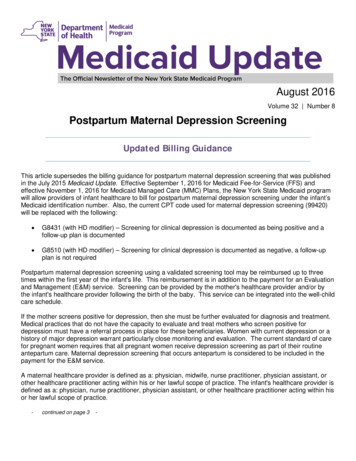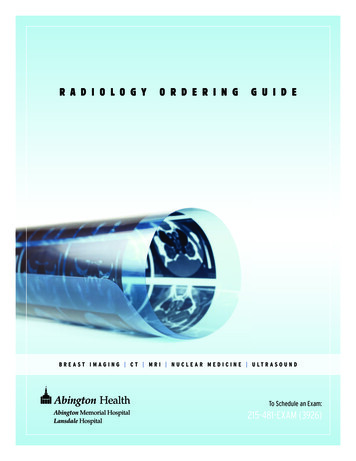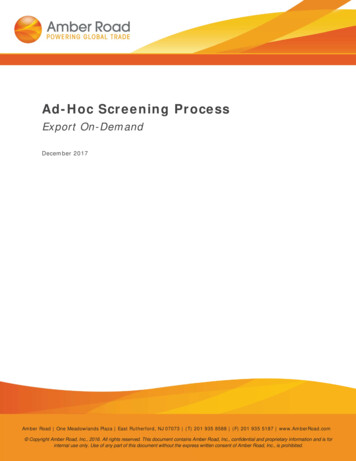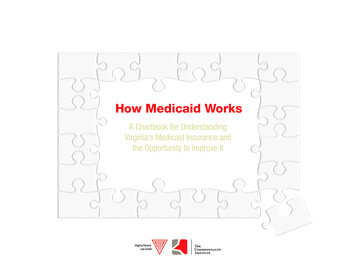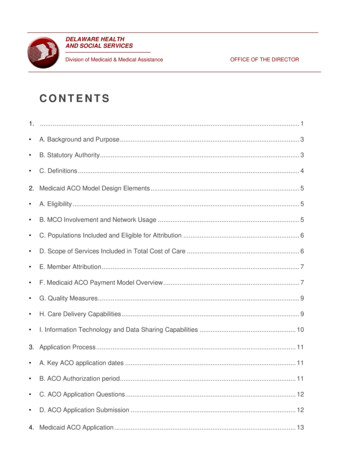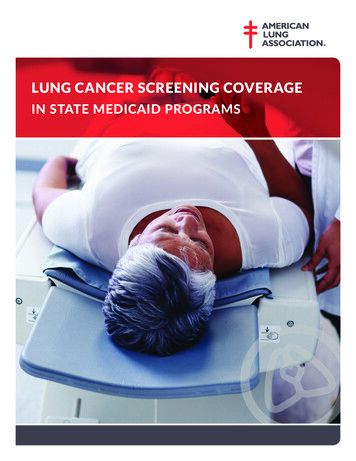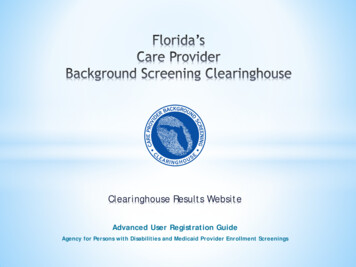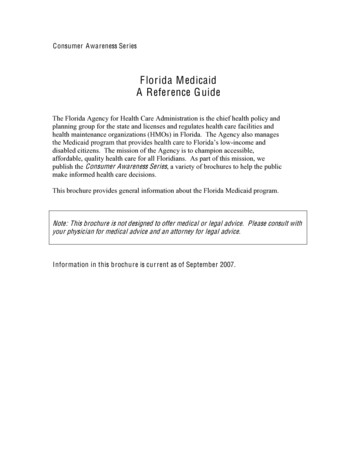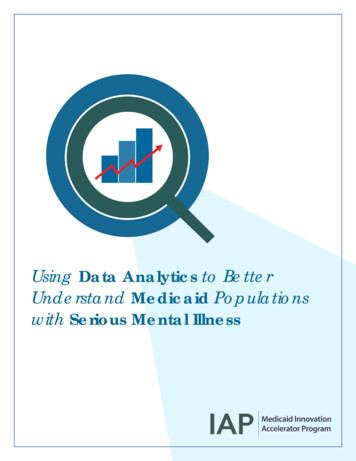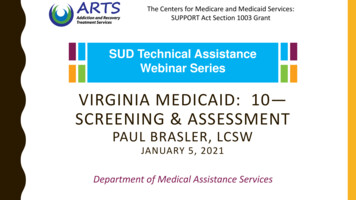
Transcription
The Centers for Medicare and Medicaid Services:SUPPORT Act Section 1003 GrantSUD Technical AssistanceWebinar SeriesVIRGINIA MEDICAID: 10—SCREENING & ASSESSMENTPAUL BRASLER, LCSWJANUARY 5, 2021Department of Medical Assistance Services
Welcome and Meeting Information WebEx participants are muted Please use Q&A feature for questionsPlease use chat feature for technical issues Focus of today’s presentation is practice-based – pleaseContact SUD@dmas.virginia.gov with technical or billingquestions SUPPORT 101 Webinar Series slide decks are availableon the DMAS ARTS website –www.dmas.virginia.gov/#/ARTS We are unable to offer CEUs for this webinar series2
COPYRIGHT This material is copyrighted by Paul Brasler, LCSW,Behavioral Health Addiction Specialist,Virginia Departmentof Medical Assistance Services No reproduction, distribution, posting or transmission ofany of this material is authorized without the expressedconsent of the author Last revision: December 22, 202020213
DISCLAIMERThe Virginia Department of Medical Assistance Services(DMAS) SUPPORT Act Grant projects are supported bythe Centers for Medicare and Medicaid Services (CMS) ofthe U.S. Department of Health and Human Services(HHS) as part of a financial assistance award totaling 4,836,765 with 100 percent funded by CMS/HHS. Thecontents are those of the author(s) and do notnecessarily represent the official views of, nor anendorsement, by CMS/HHS, or the U.S. Government.20214
Pre-Webinar SurveyIn conjunction with the VCU Wright Center and the VCU Institute for Drug and Alcohol Studies, weare conducting a survey for research purposes in order to gain a better understanding of providerimpressions and experiences of individuals with substance use disorders (SUDs), medication assisted treatment,and Medicaid. The information obtained will be used to assist in identifying potential barriers to treatingthese individuals.If you haven’t already, before the start of today’s webinar please use the link in the chat to access abrief (less than 5 minutes) electronic survey. https://redcap.vcu.edu/surveys/?s C8HERT9N3P Your name and contact information will not be linked to your survey responses. Your decision to complete the survey is completely voluntary. When exiting this webinar, you will be directed to complete the survey again as a post-training assessment.Again, it will be your decision to complete the follow-up survey or not. You are able to complete one pre and post survey per each webinar topic you attend. Your completion of the pre-webinar survey will enter you into a drawing to win a 50 Amazon gift card aswell as participation in the post-webinar survey will enter you into another 50 Amazon gift card drawing!If you have any questions about the current study, please feel free to contact, Dr. Lori Keyser-Marcusat Lori.keysermarcus@vcuhealth.org or (804) 828-4164. Thank you for helping us with this effort!
Naloxone Resources Get trained now on naloxone distribution REVIVE! Online training provided by DBHDS every Wednesday nce-abuse-services/revive/lay-rescuer-training https://getnaloxonenow.org/ Register and enter your zip code to access free online training Medicaid provides naloxone to members at no cost and without prior authorization! Call your pharmacy before you go to pick it up! Getting naloxone via mail Contact the Chris Atwood Foundation https://thecaf.acemlnb.com/lt.php?s e522cf8b34e867e626ba19d229bbb1b0&i 96A94A1A422 Available only to Virginia residents, intramuscular administration6
Website UpdateDMAS Home Page:https://www.dmas.virginia.gov/#/indexARTS Home Page:https://www.dmas.virginia.gov/#/arts7
SUPPORT Act Grant Website https://www.dmas.virginia.gov/#/artssupport8
HAMILTON RELAY TRANSCRIBER(CC) The grant team has been working closely with MontserratSerra, DMAS Civil Rights Coordinator, to provide closedcaptioning for our webinars and stakeholder meetings. We were now able to provide closed captioningthrough Hamilton Relay for all upcoming webinars. The link for transcription can be found on theWinter Webinar schedule and will be sent in the chat.20219
Today’s PresenterPaul Brasler, MA, MSW, LCSWBehavioral Health Addiction Specialist, DMASPaul Brasler is the Behavioral Health AddictionsSpecialist with the SUPPORT Grant Team at DMAS. Priorto working for DMAS, Paul was the Head of BehavioralHealth at Daily Planet Health Services, a FederallyQualified Health Center in Richmond, Virginia. Paul alsoworks in Emergency Departments conducting Psychiatricand Substance Use Disorder assessments, and in a smallmedical practice. He has worked in community mentalhealth and in residential treatment settings. He isa national presenter for PESI, specializing in training forclinicians working with high risk clients. His first book,High Risk Clients: Evidence-based Assessment & ClinicalTools to Recognize and Effectively Respond to MentalHealth Crises was published in 2019.10
Contact InformationPaul SUPPORT Act Grant Questions:SUPPORTGrant@dmas.virginia.govARTS Billing QuestionsSUD@dmas.Virginia.gov11
LANGUAGE I believe in using “Person-Centered language” as much as possible, thus:– Not “Addict,” but Person who uses drugs or Person with asubstance use/behavioral disorder– Not “Addiction,” but Substance Use Disorder (SUD)– Not “Clean,” but In Recovery or Testing Negative– Not “Dirty,” but Testing Positive– Not “Relapse,” but Return to Use At the same time, out of habit, I may inadvertently use some of theseolder words/terminology—and some of the sources I quote use olderterms Be cognizant that some people may describe themselves as “alcoholics,”“junkies,” etc., or may refer to “clean time” as how long they have beenin recovery (and we need to respect this)202112
TWO IMPORTANT THINGS YOU MUSTDO BEFORE WORKING WITH ANYCLIENTI. You must care! You must likepeople in general regardless oftheir circumstances, behaviors oropinions of youII. Find something to like in theperson you are working with—connect with them on a humanlevel202113
NO ONEsets out tobecomeaddicted tochemicals orbehaviors202114
ADDICTION DEFINED: ASAMAddiction is a treatable, chronic medical disease involving complexinteractions among brain circuits, genetics, the environment, and anindividual’s life experiences. People with addiction use substances orengage in behaviors that become compulsive and often continue despiteharmful consequences.Prevention efforts and treatment approaches for addiction are generallyas successful as those for other chronic diseases.Adopted by the ASAM Board of Directors September 15, 2019202115
SCREENING BRIEF INTERVENTION ANDREFERRAL TO TREATMENT (SBIRT) Screening: A healthcare professional assesses a member for riskysubstance use behaviors using standardized screening tools– This can occur in any healthcare setting– Positive screening results can indicate the need for furtherassessment or a brief intervention by a professional Brief Intervention: A healthcare professional engages a membershowing risky substance use behaviors in a short conversation,providing feedback and advice Referral to Treatment: A healthcare professional provides areferral to brief therapy or additional treatment to members whoscreeninneedofadditionalservices202116
SUBSTANCE USE SCREENINGTOOLSThe CAGE questionnaire was developed by Dr. JohnEwing:1.2.3.4.Have you ever felt you should Cut-Down on your drinking?Have people Annoyed you by criticizing your drinking?Have you ever felt Guilty about your drinking?Have you ever had a drink first thing in the morning to steadyyour nerves or to get over a hangover? (Eye-Opener) A ‘yes’ answer is scored as a 1 and a ‘no’ answer is scored as a 0 A score of 2 or greater is considered clinically significant202117
SUBSTANCE USE SCREENINGTOOLSSeveral screening tools, based on the CAGE, are for screeningpregnant womenTWEAK(Tolerance, Worried, Eye-opener, Amnesia, K-Cut Down)T-ACE(Tolerance, Annoyance, Cut Down, Eye Opener) Both tools assign a greater weight to a positive tolerance (2 points) score A total of score of 2 or more indicates the need for additional assessment202118
SUBSTANCE USE SCREENINGTOOLS Substance Abuse Subtle Screening Inventory (SASSI): Used tohelp determine whether a person requires a more in-depthassessment (adult and adolescent versions)– The SASSI reportedly helps identify whether a person has a “highprobability of having a substance use disorder” even if the client isless than forthcoming Alcohol Use Disorders Information Test (AUDIT-C): Used toscreen for alcohol misuse Drug Abuse Screening Test (DAST-10): Ten yes/no questions; canbe self-administered 2021Michigan Alcohol Screening Test (MAST): 24 yes/no questions19
Comprehensive assessmentof the patient is critical fortreatment planningHowever, completion of allassessments should not delay orpreclude initiatingpharmacotherapy for opioid usedisorderASAMASSESSMENTRECOMMENDATIONS(ASAM, 2020, P. 26)If not completed beforeinitiating treatment, assessmentsshould be completed soonthereafter202120
ASSESSMENT OVERVIEW All clients should receive a comprehensive behavioral health assessmentas part of the treatment process, regardless of the service setting Assessing clients includes four primary areas (plus an additionalthree areas if time permits) of focus:A. Suicide/Lethality AssessmentB. Substance Use AssessmentC. Mental Status ExamD. Basic Trauma AssessmentE. Medical & Mental Health HistoryF. Family & Social HistoryG. Physical Examination (In a medical setting)202121
ASSESSMENT OVERVIEWConsider the context and setting of the assessment: In a medical setting, I recommend a concurrent medicalassessment along with the mental health assessment—ask yourself:“What could kill the patient first?” How is the assessment room or interview space set up? How safe is the overall environment? What about distractions, intrusions or avoidable interruptions?2021What are some other ways to make the client,particularly if they are anxious, traumatized orconfused, feel safe?22
CONNECTING DURING THEINITIAL MEETINGPeople want to talk and tell their story, so give them that chance: “Why are you here?” “What’s going on?” “What do you hope to getout of coming here?” “How long has this been a problem?” “Has anything helped in the past?” “Why are you looking for help now?”Ask simple opening questions and then provide time for theclient to talk with as few interruptions as possible202123
SUICIDE/LETHALITY ASSESSMENTIN THE CONTEXT OF A SUBSTANCEUSE ASSESSMENT Given that substance use is a significant risk-factor for suicidalbehaviors, it is imperative that a suicide assessment be a part of a SUDassessment An excellent suicide assessment tool is the Columbia Suicide SeverityIndex– Or you can use the one listed in the following slides If you use any type of screening/assessment tool, do not rely solely onany numeric score to make clinical decisions I strongly recommend that all providers receive training specific tosuicide assessment and intervention202124
SUICIDE ASSESSMENT Are you having thoughts of killing or hurtingyourself?– Another way to ask: On a scale of 1 to 10 how would you rate yourdesire to kill yourself?– (If no, have you had thoughts of killing or hurting yourself or wishedyou were dead in the past two weeks?)– If you have thoughts of hurting yourself, or have tried to hurtyourself, do you want to hurt yourself without killing yourself? In what way(s) have you thought about killing or hurting yourself? Do you have access to the things you would need to kill yourself?202125
SUICIDE ASSESSMENT What has happened that you are thinking of killing yourself? How long have you been feeling this way? What has kept you from killing yourself even though you feel likekilling yourself? Have you ever tried to kill yourself in the past? What didyou do?– What happened as a result of this attempt?202126
SUICIDE ASSESSMENT Have you ever been admitted to a psychiatric hospital?– (If yes, for what reason?)– Did you admit yourself or were you admitted involuntarily?– (If no, have you ever been assessed for suicide in an emergencyroom?) Do you see a psychiatrist or counselor in the community? Haveyou seen either in the past?– Have you found your work with mental health professionals to behelpful? What has worked? What hasn’t worked? Has anyone in your family ever died by suicide?202127
SUICIDE ASSESSMENT What do you think happens to us when we die? How do you think the people who care about you will feel, or howwill they react, if you kill yourself? Do you have access to a gun, knives or medications?– (Note: I recommend asking this question even if the person hasthoughts of killing themselves by other methods [e.g., jumping orhanging] to try to get a better picture of their environment andaccess to other means) Who else knows you feel this way?202128
LETHALITY ASSESSMENT Are you having thoughts of killing or hurting anyone else?– (If no, have you had any thoughts of killing or hurting someone else in thepast two weeks?)In what way(s) have you thought about killing or hurting someone else?Why do you want to kill this person?How long have you been feeling this way?What has kept you from hurting this other person even though you feelthis way? Do you have a history of hurting people? – What happened as a result of this?(e.g., Have you ever been charged withassault or malicious wounding?)202129
DUTY TO PROTECT As noted in the 1976 California State Supreme Court ruling; Tarasoff vs.Regents of the University of California, mental health professionals have aduty to protect individuals who have been specifically threatened with deathor bodily harm by their clients– If the patient makes a threat of violence or homicidal ideation toward a specificindividual, then the clinician is required to make every reasonable effort tocontact the threatened individual and warn them of the client’s threat. I alsocontact the police– Care must be taken to divulge the minimal amount of information necessary tothe threatened person, to protect the rights of the client. No diagnostic, medical,substance abuse, or any other patient information, other than the name of theindividual who made the threat, should be divulged to the intended victim andlaw enforcement– The counselor should then document this contact in the client’s medical record202130
CLINICAL RESPONSES TO THESUICIDE/LETHALITY ASSESSMENT If during the assessment, it isevident that the clientclearly intends to harmthemselves or others, lawenforcement and/oremergency medical servicesshould be summonedimmediately An indicator of higher-risk is thelevel of detail in the planning orattempt of suicide or violence202131
ASAM CRITERIA ASSESSMENTDIMENSIONS (HERRON & BRENNAN, 2015, P. 174)AssessmentDimensionsAcute intoxicationand/or withdrawalpotentialAssessment & Treatment Planning FocusBiomedicalconditions andcomplicationsAssess and treat co-occurring physical healthconditions or complications. Treatment providedwithin the level of care or through coordination orphysical health services2021Assessment for intoxication or withdrawalmanagement. Withdrawal management in avariety of levels of care and preparation forcontinued addiction services32
ASAM CRITERIA ASSESSMENTDIMENSIONS (HERRON & BRENNAN, 2015, P. 174)AssessmentDimensionsAssessment & Treatment Planning FocusEmotional,behavioral, orcognitive conditionsand complicationsAssess and treat co-occurring diagnostic or subdiagnostic mental health conditions or complications.Treatment provided within the level of care orthrough coordination of mental health servicesReadiness to change Assess stage of readiness to change. If not ready tocommit to full recovery, engage into treatment usingmotivational enhancement strategies. If ready forrecovery, consolidate and expand action for change202133
ASAM CRITERIA ASSESSMENTDIMENSIONS (HERRON & BRENNAN, 2015, P. 174)AssessmentDimensionsRelapse, continueduse, or continuedproblem potentialAssessment & Treatment Planning FocusRecoveryenvironmentAssess need for specific individualized family orsignificant others, housing, financial, vocational,educational, legal, transportation, childcare services.Identify any supports and assets in any or all of the areas2021Assess readiness for relapse prevention services andteach where appropriate. Identify previous periods ofsobriety or wellness and what worked to achieve this. Ifstill at early stages of change, focus on raisingconsciousness of consequences or continued use orcontinued problems as part of motivationalenhancement strategies34
SUBSTANCE USE ASSESSMENTSubstance Use History:A. Substances used (including tobacco, alcohol and caffeine) [“Tell meabout your drug use”]B. Last use (for each drug) [“When did you last use?”]C. Current drug use [“What is your drug use like during an averageweek?”]D. Routes of use (for each substance)E. Durations of use (for each substance) [“How long have you beenusing?”]F. Amounts of use (for each substance) [“How much do you use?”]202135
SUBSTANCE USE ASSESSMENTG. Tolerance (having to use more of a chemical to get the samereaction as before)H. Withdrawal symptomsI. Impact on education, job, relationships, health, legal problemsJ. Past treatment; periods of sobriety or recoveryK. Motivation for treatmentL. Family history of substance use202136
MENTAL STATUS EXAMEXAMINES THE FOLLOWING Appearance Attitude– Rapport Behaviors Mood Affect– Range of expression Speech– Volume– Rate2021 Thought process Thought content– Delusions– Hallucinations– Obsessions Cognition– Orientation– Memory Reliability Insight Judgement37
BASIC TRAUMA ASSESSMENTPrimary Care PTSD Screen: (Prins, et al., 2003)“Have you ever had an experience in your life that was sofrightening, horrible, or upsetting that you:” “Had nightmares about it or thought about it when you didn’twant to?” “Tried hard not to think about it or went out of your way to avoidsituations that remind you of it?” “Were constantly on guard, watchful, or easily startled?” “Felt numb or detached from others, activities, or yoursurroundings?”202138
MENTALHEALTHHISTORY Symptoms:– Duration– Intensity Treatment:– Type– Duration– Effectiveness Medications:– Side-effects Family history of mental illness,including suicides, suicide attempts andpsychiatric hospitalizations202139
BASIC NEEDSAppetite: A decrease in appetite is a common symptom of depression “When is the last time you had something to eat?” “Have there been any changes to your appetite recently?”Sleep: Sleep problems often precipitate many psychiatric problems Insomnia or hypersomnia are also common symptoms for a variety ofmental health problems “Have there been any changes to your sleep recently?”Housing202140
“WHATWILL KILLTHEPATIENTFIRST?”ALWAYSRULE OUTMEDICALPROBLEMS202141
SIGNS & SYMPTOMSSigns and symptoms are often used interchangeably inclinical terminology; however, they have specific meanings: Signs can be detected by someone other than the patient (e.g.,elevated heart rate or blood pressure) Symptoms are experienced and reported by the patient (e.g.,depression, anxiety or pain)Distinguishing between medical and mental health problems,or specifically, ruling out a medical problem, requires medicaltesting and attention to the symptom profile—obtain amedical assessment202142
MEDICAL ASSESSMENT Vital signs:–––––Body temperatureBlood oxygen levelHeart rateRespirationsBlood pressure Blood work:–––––2021Complete blood countBlood chemistryMetabolic panelBlood alcohol levelTherapeutic medication bloodlevels Urine Testing:– Urinalysis– Urine drug screen Pregnancy Test Electrocardiogram (EKG/ECG) Medical imaging:– X-ray– C-T scans Physical exam by a medicalprovider43
MEDICAL PROBLEMS THAT MAY APPEARAS MENTAL HEALTH OR SUD ISSUES Delirium Hypoxia Blood sugar levels too high ortoo low Urinary Tract Infections Stevens-Johnson Syndrome Medication allergies Stroke Neuroleptic MalignantSyndrome2021 Cancer Brain bleeds Medication reactions Thyroid levels too high or toolow Traumatic Brain Injury Environmental poisonings Chronic illnesses (MultipleSclerosis, H.I.V./A.I.D.S.)44
REFERENCES202145
REFERENCES American Society of Addiction Medicine. (2020). The ASAM national practice guideline for thetreatment of opioid use disorder: 2020 focused update. Rockville, MD: Author. Brasler, P. (2019). High risk clients: Evidence-based assessment & clinical tools to recognize andeffectively respond to mental health crises. Eau Claire, WI: PESI Media & Publishing. Chan, A.K., Pristach, E.A., Welte, J.W. & Russell, M. (1993). “The TWEAK test in screening foralcoholism/heavy drinking in three populations.” Alcoholism: Clinical and Experimental Research,6. 1188 – 1192. Herron, A.J. & Brennan, T.K. (2015). The ASAM essentials of addiction medicine, 2nd Ed. AmericanSociety of Addiction Medicine. New York: Wolters Kluwer. Maris, R.W. (2019). Suicidology: A comprehensive biopsychosocial perspective. New York: TheGuilford Press. Prins, A., Ouimette, P., Kimerling, R., Cameron, R., Hugelshofer, D., Shaw-Hegwer, J., Thrailkill, A.,Gusman, F., & Sheikh, J. (2003). “The primary care PTSD screen (PC-PTSD): Development andoperating characteristics.” Primary Care Psychiatry, 9 (1). 9 – 14. Russel, M. (1994). “New assessment tools for risk drinking during pregnancy: T-ACE, TWEAKand others.” Alcohol Health and Research World.202146
behaviors, it is imperative that a suicide assessment be a part of a SUD assessment An excellent suicide assessment tool is the Columbia Suicide Severity Index -Or you can use the one listed in the following slides If you use any type of screening/assessment tool, do not rely solely on any numeric score to make clinical decisions

